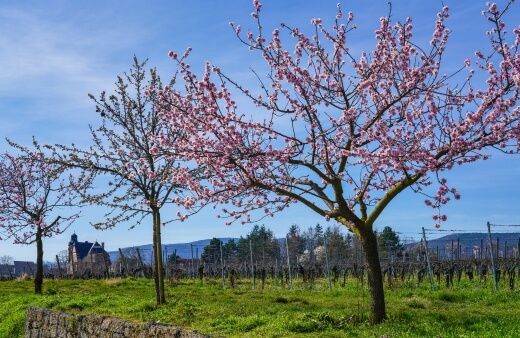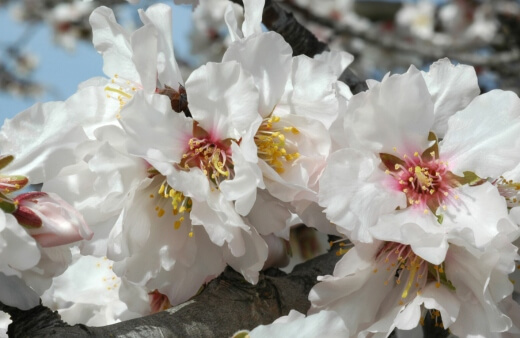Almond trees produce masses of delicious and nutritious almonds and grow incredibly well in our climate here in Australia. But as well as being productive, they make wonderfully ornamental trees, with gorgeous green foliage and stunning winter structure.
Almonds are native to the Middle East but are now grown commercially and domestically in many parts of the world, including Australia. Growing an almond tree is rewarding, but you’ll need to put a little bit of effort in to get the most out of these productive plants.
In this guide, we will explore how to grow an almond tree in your garden, including planting, watering, propagating, caring for, and harvesting almonds.
More...

Family: | Rosaceae |
|---|---|
Genus: | Prunus |
Species: | P. dulcis |
Common Names: | Almond tree |
Origin: | Middle East and South Asia |
Location: | outdoor |
Type: | tree |
Growth: | 10-12 metres tall |
Sun requirements: | full sun |
Foliage Colour: | green |
Flower Colour: | pink or white |
Flowering: | Late winter to early spring |
Edible Parts: | nut |
Maintenance level: | medium |
Poisonous for pets: | The leaves and twigs contain cyanide and can be toxic if ingested by pets. Many pets are allergic to the nuts |
What are Almond Trees?
An almond tree (Prunus dulcis) is a deciduous tree that belongs to the Rosaceae family. It is closely related to peach and apricot trees and is native to the Middle East. Almond trees, as you may have guessed, produce almonds, which are one of the most commonly eaten nuts in the world, and can grow up to 10 metres in height with an elegantly spreading canopy.
Nearly all almond trees sold for garden cultivation will be grown on a grafted rootstock, allowing for a wider range of species to be grown at home, using strong root stock which will limit their size as well and is usually on a hardier root with better disease resistance.
Natural Habitat of Prunus dulcis
Almond trees are native to the Middle East and are well-adapted to growing in warm, arid climates. They are typically found in regions with hot summers and mild winters, and they prefer well-draining soils that are not too wet.
Almond trees can be grown in many parts of Australia, particularly in regions with a Mediterranean climate.
How to Grow Almond Trees

How to Plant Almond Trees and When to Do It
The best time to plant almond trees in Australia is in late winter or early spring, which is typically from July to September. Choose a site that receives full sun for most of the day and has well-draining soil.
The soil should be slightly acidic, with a pH of around 6.5. If the soil is too alkaline, add some sulphur to the soil to lower the pH.
Before planting, prepare the soil by digging a hole that is twice the size of the tree's root ball. Mix some organic matter, such as compost or well-rotted cow or horse manure, into the soil.
Place the tree in the hole, making sure that the graft union (the swelling near the base of the trunk) is above the soil level. Backfill the hole with soil, and tamp it down firmly. Water the tree well after planting.
Soil & Drainage
Almond trees prefer free-draining soils, so sandy loam is ideal. They can tolerate a wide range of soil types, including sandy, loamy, and clay soils.
Water Requirements
Almond trees need regular watering, especially during the first few years after planting. They prefer deep, infrequent watering, rather than frequent shallow watering.
Water the tree deeply once a week through summer, maybe twice in dry spells and heat waves, and reduce watering in the winter when the tree is dormant. Almond trees are drought-tolerant, but they need regular watering to produce a good crop of almonds.
Light & Temperature for Better Harvests
Almond trees require full sun for most of the day to produce a good crop of almonds. They can tolerate a wide range of temperatures, but they prefer warm, arid climates.
Almond trees need a certain number of chill hours (hours of cold temperatures) during the winter to produce a good crop of almonds. The number of chill hours required varies depending on the cultivar, but most almond trees need between 400-800 chill hours.

Growing Almond Trees in Pots
Almond trees can be grown in pots, but they require a large container to accommodate their deep root system. Choose a container that is at least 60 cm deep and has a similar diameter.
If possible, insert a plastic pot into a terracotta or decorative ceramic/timber container to reduce the need for watering.
To ensure proper drainage for a potted almond tree, it is essential to add a layer of gravel or stones at the bottom of the container. This will help excess water drain away from the roots and prevent waterlogging.
It's best to use a high-quality potting mix with added organic matter, such as compost or aged manure, to provide the tree with the necessary nutrients, and mulch once a year or feed monthly.
(Make your own compost with ease with the help of our kitchen compost bins buying guide.)
When planting the almond tree in the pot, make sure that the soil level is about an inch below the rim of the container. This will leave enough space for watering without causing the water to overflow.
Potted almond trees will require more frequent watering than those planted in the ground, as the soil in the pot will dry out more quickly. Water the tree deeply once or twice a week, depending on the climate and season, and ensure that the soil remains consistently moist but not waterlogged.
Potted almond trees will also benefit from regular applications of fertiliser, as nutrients in the potting mix will eventually become depleted. Use a balanced fertiliser once a month during the growing season to keep the tree healthy and productive.
Harvesting Almonds

When to Harvest Almonds
When you harvest almonds will depend on the variety of almond tree and the climate in which it is grown. In Australia, most almond varieties are harvested in late summer or early autumn, usually around February or March.
However, some varieties may be ready to harvest as early as December, and others may not be ready until April. To determine if almonds are ready to harvest, look for signs that the hulls have started to split open.
The hulls are the green outer layer that surrounds the almond shell. As the almonds mature, the hulls will begin to dry out and split, revealing the nut inside. To check if the almonds are ready, gently squeeze the hulls. If they come away easily, it's time to harvest.
How to Harvest Almonds
To harvest almonds, spread a tarp or sheet beneath the tree to catch the nuts as they fall. Use a long pole or rake to shake the branches gently and encourage the almonds to drop.
Alternatively, you can simply wait for the almonds to fall naturally. Once the almonds have been harvested, they will need to be dried and cured before they can be stored or eaten.
Remove the hulls completely, scrubbing them off if necessary, then spread the nuts out in a single layer on a clean, dry surface, and leave them in a warm, dry place for a week or two, turning them occasionally.
This will help to dry out any remaining moisture and prevent mould from forming. Once the almonds are dry, they can be stored in an airtight container in a cool, dry place for up to a year.
Almond Tree Pests and Diseases
Like all plants, almond trees are susceptible to a range of pests and diseases. Some of the most common almond tree pests include:
- Aphids: These small insects feed on the sap of the tree and can cause stunted growth and distorted leaves.
- Mites: Spider mites and other mites can cause yellowing and damage to the leaves and buds of the tree.
- Scale insects: These insects attach themselves to the trunk and branches of the tree and feed on the sap, causing weakened growth and dieback.
- Borers: Borers are beetle larvae that tunnel into the trunk and branches of the tree, causing damage and potentially killing the tree.
- Shot hole disease: A fungal disease that causes small, circular holes in the leaves and can lead to defoliation.
- Blossom blight: A bacterial disease that affects the flowers of the almond tree, causing them to turn brown and fall off.
- Root rot: A fungal disease that causes the roots of the tree to turn mushy or black before leaves turn crisp and drop.
Almond Trees Frequently Asked Questions

How long does it take for an almond tree to produce nuts?
Almond trees can start producing nuts after three years, but it may take up to five years for a significant harvest. Once they start producing nuts, the yield will increase each year.
How often should I water my almond tree?
Almond trees need regular watering, especially during dry summers. They should be watered deeply once a week or more often in hot weather. Avoid watering too frequently, as this can lead to root rot.
Can almond trees be grown in containers?
Almond trees can be grown in containers. Choose a large container that is at least 60 cm deep and has a diameter of at least 45 cm. Make sure the container has drainage holes and use a well-draining potting mix.
When is the best time to prune almond trees?
Almond trees should be pruned during their dormant period, which is typically in winter after the leaves have fallen off. This will help stimulate new growth and improve the tree's overall health.
How do I know when almonds are ready to harvest?
Almonds are ready to harvest when the hulls split open, revealing the nut inside. You can test the hulls by gently squeezing them. If they easily crack open, the almonds are ready to be harvested.
Can almond trees be grown in all parts of Australia?
Almond trees can be grown in most parts of Australia, but they thrive in areas with a Mediterranean climate. They prefer dry, warm summers and mild winters.
Are almond trees self-pollinating or do they need a pollinator?
Most almond trees are not self-pollinating and need a pollinator to produce nuts. Make sure you plant two or more almond trees of different varieties to ensure cross-pollination.
How long do almond trees live?
Almond trees can live up to 50 years with proper care and maintenance, though many are thought to be well over 200 years old.
Wrapping Up Our Guide to Growing and Caring for Almond Trees in Australia
Growing an almond tree in your garden can be a rewarding experience, providing you with fresh, healthy nuts and a beautiful tree to add to their appeal. Without too much effort, you can successfully grow and harvest almonds from your own almond tree, in your own garden, wherever you are in Australia.
Published on May 19, 2023 by Maisie Blevins
Last Updated on February 23, 2024




